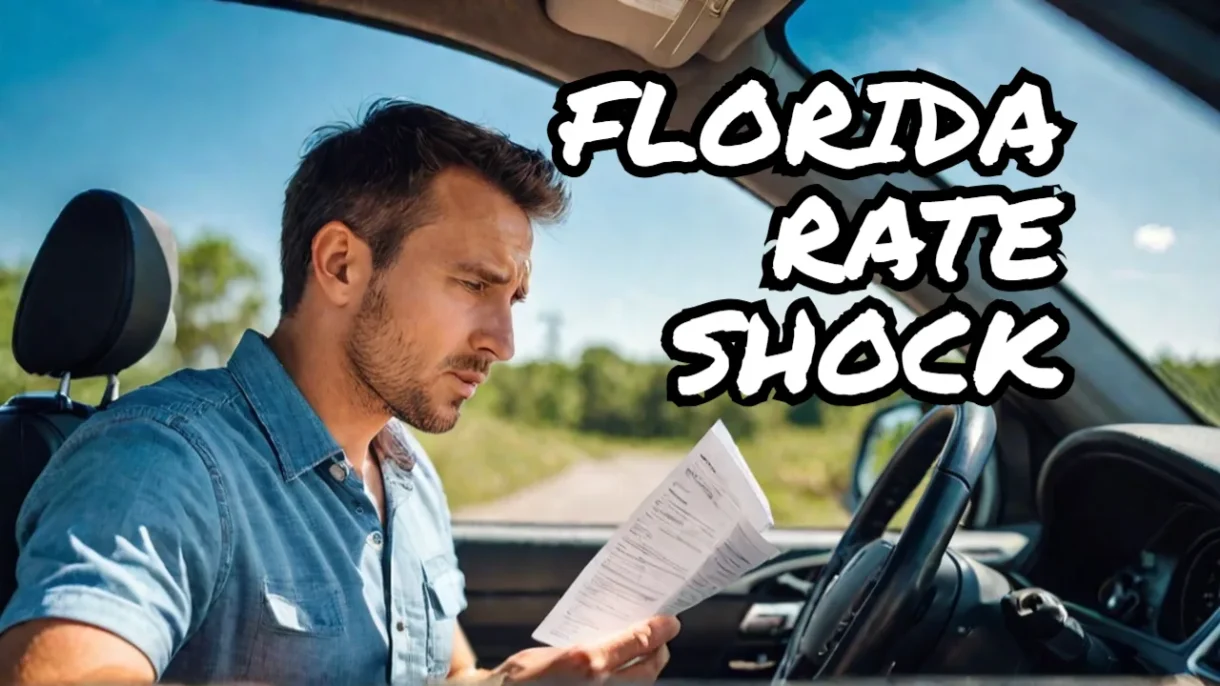If you’re a driver in Florida, you know the feeling: the thud of the auto insurance bill arriving, followed by the sticker shock of a premium that seems to defy logic. For many, this means a bill that can average over $2,900 a year for full coverage—one of the highest rates in the nation.
Table of contents
- Introduction: The Sunshine State Sticker Shock
- 1. Florida Isn’t Just a State; It’s a “Judicial Hellhole”
- 2. The Paradox of “No-Fault” Insurance
- 3. The Great Windshield Replacement Scam
- 4. The 1-in-5 Gamble: Dodging Uninsured Drivers
- 5. The Unbelievable Plot Twist: Rates Are Finally Starting to Drop
- Conclusion: A Cautious Optimism for Florida Drivers
Introduction: The Sunshine State Sticker Shock
While it’s easy to blame inflation or hurricanes, the real reasons are a story of systemic flaws and unintended consequences. Well-intentioned policies designed to help consumers were exploited by a uniquely aggressive legal environment, creating a perfect storm of costs. This article will break down the five interconnected drivers behind your expensive policy, and reveal an unexpected plot twist that is finally bringing some relief.
——————————————————————————–
1. Florida Isn’t Just a State; It’s a “Judicial Hellhole”
One of the biggest drivers of high insurance costs is an extremely litigious environment. According to a report analyzing court data, Florida has 127.41 personal injury cases filed per 100,000 people. In an ironic twist, this data was compiled by a Florida personal injury law firm, Anidjar & Levine, which noted the figure is “a staggering 1,237% over the national average rate of just 9.53.” This sheer volume of lawsuits creates enormous costs and uncertainty for insurers, who then pass that financial risk on to customers through higher premiums. The problem became so severe that it prompted direct action from the state’s highest office.
“Florida has been considered a judicial hellhole for far too long and we are desperately in need of legal reform that brings us more in line with the rest of the country.” — Governor Ron DeSantis
This hyper-litigious environment found its perfect fuel in Florida’s own “no-fault” insurance system, a policy designed to reduce lawsuits that ironically ended up encouraging them.
——————————————————————————–
2. The Paradox of “No-Fault” Insurance
Florida is one of only two states that require a no-fault system, which includes mandatory Personal Injury Protection (PIP) coverage. The system was designed to speed up medical payments and reduce litigation by having a driver’s own insurer cover the first wave of medical bills. PIP is designed to pay for 80% of your medical bills up to $10,000 for an emergency medical condition, regardless of who caused an accident.
The counter-intuitive result is that this $10,000 benefit has unintentionally fueled systemic fraud. A “whole cottage industry of phony medical providers” has emerged, submitting fraudulent bills to insurance companies. These operations often charge for unnecessary or fake treatments until the $10,000 PIP limit is exhausted. This widespread fraud directly contributes to the higher premiums every Florida driver pays.
Nowhere is this combination of legal loopholes and profit motive more visible than in the uniquely Floridian phenomenon known as the windshield replacement scam.
——————————————————————————–
3. The Great Windshield Replacement Scam
As a direct example of the litigious culture in action, consider a scam involving something as simple as a car windshield. The scenario is common: a contractor approaches a driver in a parking lot offering a “free” windshield replacement, promising their insurance will cover the full cost. When the driver signs the paperwork, however, they are often unknowingly signing an “assignment of benefits” (AOB).
This AOB allows a law firm to take over the claim, leading to an explosion of lawsuits against insurers for inflated costs. This loophole has been heavily exploited, with lawsuits related to auto glass AOBs increasing by more than 4,000% over the last decade. In 2022 alone, a record 33,196 such lawsuits were filed, clogging the courts and driving up costs for everyone.
——————————————————————————–
4. The 1-in-5 Gamble: Dodging Uninsured Drivers
Another major risk factor driving up costs is the high percentage of uninsured drivers on Florida roads. Approximately one in five drivers in Florida (20.4%) is uninsured, giving the state the sixth-highest rate in the nation. This creates a massive financial risk for everyone else.
When an accident involves an uninsured motorist, the costs are often covered by the insured driver’s own policy. This makes Uninsured Motorist (UM) coverage, while often optional, a near-necessity for financially responsible drivers in Florida, adding another layer of cost to their policies. To compensate for this elevated risk pool, insurance companies raise premiums for all policyholders. In essence, responsible, insured drivers end up subsidizing the irresponsibility of others.
——————————————————————————–
5. The Unbelievable Plot Twist: Rates Are Finally Starting to Drop
After years of relentless increases, there are clear signs that the market is stabilizing and rates are beginning to decrease. This surprising and positive turn is a direct result of statewide insurance reforms passed in 2022 and 2023 that specifically targeted litigation abuse. The impact has been swift and significant.
• Florida’s top five auto insurance groups, which cover 78% of the market, are indicating an average rate change of -6.5% for 2025. This is a dramatic reversal from the +31.7% average increase seen in 2023.
• State Farm recently cut its rates by an average of 10%, bringing its total rate reductions since October 2024 to over 20%.
• Progressive Insurance announced plans to return nearly $1 billion in excess profits to its auto insurance customers.
These reforms worked by tackling the core problem. A key change was the elimination of “one-way attorney’s fees,” a rule that forced insurers to pay the legal fees for plaintiffs who sued them, regardless of the outcome. This created a no-risk incentive for the explosion of lawsuits seen in windshield and PIP claims. By removing that incentive, the reforms have dramatically reduced litigation, allowing insurers’ costs to fall.
“We are seeing steady signs of auto insurance rates dropping in Florida. Thanks again to effective legislative reforms, Florida’s auto insurance market continues to improve… This is great news, and I’m glad consumers will start feeling relief in their premiums soon.” — Insurance Commissioner Mike Yaworsky
——————————————————————————–
Conclusion: A Cautious Optimism for Florida Drivers
While a perfect storm of rampant lawsuits, systemic fraud, and a high number of uninsured drivers made Florida one of the most expensive states for car insurance, recent legislative reforms are proving to be powerful and effective.
This new market stability has re-ignited competition, making it more crucial—and rewarding—than ever for consumers to shop around. With more than 50 auto insurers in the state, rates can vary significantly, and the company that was cheapest last year may not be the cheapest today. For the first time in years, the financial pressure on Florida drivers is easing, but is this the beginning of a long-term solution or just a temporary reprieve?
- 0Email
- 0Facebook
- 0Twitter
- 0Pinterest
- 0LinkedIn
- 0Like
- 0Digg
- 0Del
- 0Tumblr
- 0VKontakte
- 0Reddit
- 0Buffer
- 0Love This
- 0Weibo
- 0Pocket
- 0Xing
- 0Odnoklassniki
- 0WhatsApp
- 0Meneame
- 0Blogger
- 0Amazon
- 0Yahoo Mail
- 0Gmail
- 0AOL
- 0Newsvine
- 0HackerNews
- 0Evernote
- 0MySpace
- 0Mail.ru
- 0Viadeo
- 0Line
- 0Flipboard
- 0Comments
- 0Yummly
- 0SMS
- 0Viber
- 0Telegram
- 0Subscribe
- 0Skype
- 0Facebook Messenger
- 0Kakao
- 0LiveJournal
- 0Yammer
- 0Edgar
- 0Fintel
- 0Mix
- 0Instapaper
- 0Print
- Share
- 0Copy Link









